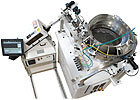
This laser-based sorting system automatically checks the length, width and thread characteristics of screws and bolts. Photo courtesy General Inspection LLC
In fact, threaded fasteners get the same thorough going-over as the assemblies they eventually go into. I recently toured the production facilities of Semblex Corp. (Elmhurst, IL), one of the top fastener manufacturers in North America, and I came away with a newfound respect for the work that goes into these seemingly simple parts.
The quality checks start before a single fastener is even produced. Technicians verify the performance of forming dies using a special alloy that melts at a low temperature. The molten metal is poured into the die, where it quickly solidifies in the shape of the blank fastener. The critical dimensions of the blank are then checked for accuracy.
The checks continue at the heading machine, where steel wire is straightened, drawn, cut and cold-formed into the desired size and shape. Depending on the fastener and the machine, blank screws can be produced as fast as 500 per minute. Engineering drawings show the part dimensions at each stage of the process, and operators use calipers, gauges and comparators to measure the parts periodically. In addition, photographs show examples of good and bad fasteners.
The story is much the same at the thread-rolling machine, where the blanks are squeezed and rolled between two dies. If the part calls for a captivated washer, some clever mechanical selectors ensure that only screws with washers reach the thread-rolling dies.
Next, the fasteners are sent off for heat treating, finishing and, in some cases, the application of an adhesive or sealant. When the fasteners return, they are sorted to weed out nonconforming parts and foreign material.
This can be accomplished in many ways. The simplest is roller sorting. Fasteners are fed to a pair of adjustable rollers that splay outward and down from the feed point. Parts travel the length of the rollers and fall into bins at predetermined locations. Parts that are too thin drop through the rollers early. Those that are too wide drop late. Those that are just right fall out somewhere in the middle.
Bowl sorting is similar. Instead of rollers, however, fasteners are fed to a vibratory bowl. As the fasteners travel up the bowl’s spiral track, they pass through a series of mechanical gates that weed out nonconformers.
A more high-tech option is a laser- or vision-based system. In this case, fasteners are fed to a linear track or the rim of a rotary indexing table. Whereas roller and bowl sorting can catch gross dimensional errors, laser- or vision-based systems can measure such variables as shank length, shank diameter, thread pitch, helix angle, head height and head diameter-all in a fraction of a second. These systems can also spot cracked heads, missing washers, and malformed threads and drive recesses.
Whether mechanical or optical, every sorting system is tested using a handful of fasteners that have at least one nonconforming characteristic. Known as a boundary sample, these fasteners are painted red and periodically mixed in with the fasteners to be sorted. If five red fasteners are put in, all five had better end up in a reject bin!
No sorting method can inspect every fastener attribute. The best method to use depends on what defects assemblers hope to catch, what fastener characteristics are most important to the assembly, and what assemblers are willing to pay for. It’s also important to note that a defect rate of 0 parts per million is simply not achievable, given the production volumes and the number of processing steps in fastener manufacturing.
Even after sorting, the quality checks don’t stop. A sample from every batch of fasteners is sent to an on-site lab, which runs tests for hardness, material composition, corrosion, tensile and torsional strength, and drive characteristics. To ensure the traceability of each lot, the entire production process is documented, from the incoming wire to the finished product.






